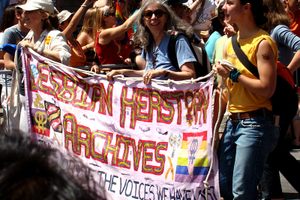About
Concealed from the sprawled picnickers, dogs catching frisbees, and endless rotations of bicyclists in Prospect Park is a 19th century Quaker cemetery.
The Friends Cemetery was established on what was then undeveloped farmland on the border between Brooklyn and the town of Flatbush and now contains some 2,000 graves. It continues to be an active cemetery for the local Quaker community, yet for most visitors to the Brooklyn park it is completely invisible.
While Prospect Park opened in 1867, the cemetery was established by the Society of Friends in 1849, although burials had been conducted there since at least the 1820s. As tombstones weren’t allowed in Quaker cemeteries until the 1850s, most of the early graves are unmarked and the more recent are only memorialized with the simplest of markers. Significant Quakers such as Raymond Ingersoll, who was Brooklyn Borough President, are interred in the 10 acre cemetery, as is the actor Montgomery Clift. The star of “A Place in the Sun” who suffered a scarring car crash and later died at the age of 45 in 1966 was buried in the cemetery at his Quaker mother’s request.
The cemetery is closed to the public and surrounded with a fence, although there are occasional tours and special events when it is open. Following Center Drive near the park entrance at Prospect Park Southwest and 16th Street, observant park goers can try to glimpse the wooded area that hides the Friends Cemetery.
Related Tags
Published
September 6, 2011
Sources
- “The Complete Guidebook to Prospect Park and the Brooklyn Botanic Gardens,” Richard J. Berenson, Neil Demause: http://books.google.com/books?id=xDkdA2Yi7swC
- “Forgotten New York,” Kevin Walsh: http://books.google.com/books?id=ViZNSexza6MC
- “He's Here for Eternity, but Don't Ask Where,” New York Times: http://www.nytimes.com/1998/09/27/nyregion/neighborhood-report-prospect-park-park-slope-he-s-here-for-eternity-but-don-t.html






































